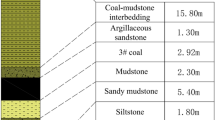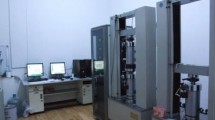Abstract
Coal mines in Pingdingshan mining area, Henan province, China, are commonly mined at a great depth up to 1000 m, and inevitably reside in high temperature, high pressure, high permeability, strong mining disturbance, and strong time effect environment. Support structures of the mines in the area are vulnerable to failure and destruction while roadway stability has been a long-standing issue in the region. Based on the specimens collected from the roof of the return-air rise at Pingdingshan No.1 coal mine, here, we investigated the creep characteristics of sandy mudstone under triaxial conditions and developed a constitutive relationship to predict the creep behavior. Parameter identification and sensitivity analysis were performed to determine the influential factors of creep deformation. We showed that the creep deformation and steady-state creep rate at Pingdingshan coal region grow as axial stress is elevated while descend with increased confining pressure. However, the maximum creep deformation of sandy mudstone increases with a higher confining pressure. Thereby, stress difference, elastic modulus and coefficient of viscosity are the major parameters controlling creep deformation. Hence, it is important to enhance the support strength and mechanical properties of the surrounding rock, to better the roadway stability. In addition, numerical simulation was also conducted for simple excavation geometries to analyze different support structures. On this basis, the “cable bolts steel arch, deep and shallow reinjection, floor pressure relief and local reinforcement” scheme was proposed and field practice showed promising results. The findings in this study can be used to guide the support design for the deep soft rock roadway (DSRR).

















Similar content being viewed by others
Abbreviations
- DSRR:
-
Deep soft rock roadway
- RSR:
-
Roadway surrounding rock
- ISRM:
-
International Society for Rock Mechanics and Rock Engineering
- SEM:
-
Scanning electron microscope
- MTS:
-
Material testing system
- σ c :
-
Uniaxial compressive strength
- σ t :
-
Tensile strength
- E 1, E 2 :
-
Elastic moduli of the original elastomers
- η 1, η 2, η 3 :
-
Viscosity coefficients of the three original viscous elements
- σ s :
-
Yield stress
- \(\mathop \varepsilon \limits^{\sim }\) :
-
Laplace transform of ε
- s :
-
Complex variable of Laplace transform
- t :
-
Creep time
- \(t\left| {_{{\varepsilon = \varepsilon_{a} }} } \right.\) :
-
The time when rock enters the accelerating creep state
- k、m :
-
Laboratory parameters that are dependent on material
- P a :
-
Atmosphere pressure
- σ 1 :
-
Axial stress
- σ 3 :
-
Confining pressure
- k 0、k 1、c 0、c 1 :
-
Laboratory parameters that are dependent on material
- n :
-
Creep index
References
Aydan Ö, Ito T, Özbay U, Kwasniewski M, Shariar K, Okuno T, Özgenoğlu A, Malan DF, Okada T (2014) ISRM suggested methods for determining the creep characteristics of rock. Rock Mech Rock Eng 47(1):275–290. https://doi.org/10.1007/s00603-013-0520-6
Bonini M, Debernardi D, Barla M et al (2009) The mechanical behaviour of clay shales and implications on the design of tunnels. Rock Mech Rock Eng 42:361–388
Cao P, Youdao W, Yixian W et al (2016) Study on nonlinear damage creep constitutive model for high-stress soft rock. Environ Earth Sci 75(10):900
Carpinteri A, Cornetti P (2002) A fractional calculus approach to the description of stress and strain localization in fractal media. Chaos Soliton Fract 13:85–92
Chong MA, Bin HU, Hong BZ et al (2017) Effects of osmotic pressure and confining pressure on the rheological properties of silty mudstone. J Yangtze River Sci Res Inst 34(05):92–98
Cui XH (2007) The study on rheological properties of rocks undergoing disturbance and experimental system. Shandong University of Science and Technology, Qingdao, pp 78–81
Fu Z, Chen S, Shi B (2018) Large-scale triaxial experiments on the creep behavior of a saturated rockfill material. J Geotech Geoenviron Eng 144(7):04018039
He Q, Li Y, Xu J et al (2020) Prediction of mechanical properties of igneous rocks under combined compression and shear loading through statistical analysis. Rock Mech Rock Eng 53(2):841–859
He MC (2006) Rock mechanics and hazard control in deep mining engineering in China. Proceedings of the 4th Asian Rock Mechanics Symposium. World Scientific Publishing Co., Ltd, Singapore, 29–46
Huang QX, Wang XF, Chen XY et al (2020) Evolution of interior and exterior bearing structures of the deep-soft-rock roadway: from theory to field test in the Pingdingshan mining area. Energies 13(17):4357
Kang HP (2014) Support technologies for deep and complex roadways in underground coal mines: a review. Int J Coal Sci Technol 1(3):261–277
Kang HP, Wu YZ, Gao FQ (2011) Deformation characteristics and reinforcement technology for entry subjected to mining-induced stresses. J Rock Mech Geotech Eng 3(3):207–219
Li GF, He MC, Zhang GF et al (2010) Deformation mechanism and excavation process of large span intersection within deep soft rock roadway. Min Sci Technol 20(1):28–34
Malan DF (1999) Time-dependent behavior of deep level tabular excavations in hard rock. Rock Mech Rock Eng 32(2):123–155
Mostafa S, Abolfazl T, Mohammad AM (2013) Time-dependent behavior of tunnel lining in weak rock mass based on displacement back analysis method. Tunn Undergr Space Technol 38:348–356
Nadimi S, Shahriar K, Sharifzadeh M et al (2011) Triaxial creep tests and back analysis of time-dependent behavior of Siah Bisheh cavern by 3-Dimensional Distinct Element Method. Tunn Undergr Space Technol 26:155–162
Qi YJ, Jiang Q, Wang Z et al (2012) 3D creep constitutive equation of modified Nishihara model and its parameters identification. Chin J Rock Mech Eng 31(2):347–355
Qin D, Wang X, Zhang D et al (2019) Study on surrounding rock-bearing structure and associated control mechanism of deep soft rock roadway under dynamic pressure. Sustainability 11(7):1892
Rouabhi A, Tijani M, Rejeb A (2007) Triaxial behaviour of transversely isotropic materials: application to sedimentary rocks. Int J Numer Anal Meth Geomech 31(13):1517–1535
Song ZP, Yang TT, Jiang AN et al (2016) Experimental investigation and numerical simulation of surrounding rock creep for deep mining tunnels. J South Afr Inst Min Metall 116(12):1181–1188
Srivastava LP, Singh M (2015) Effect of fully grouted passive bolts on joint shear strength parameters in a blocky mass. Rock Mech Rock Eng 48:1197–1206
Sun LH, Wu HY, Yang BS et al (2015) Support failure of a high-stress soft-rock roadway in deep coal mine and the equalized yielding support technology: a case study. Int J Coal Sci Technol 2(4):279–286
Tang H, Wang D, Huang R et al (2018) A new rock creep model based on variable-order fractional derivatives and continuum damage mechanics. Bull Eng Geol Env 77(1):375–383
Ulusay R, Hudson JA (2007) The complete ISRM suggested methods for rock characterization, testing and monitoring: 1974–2006. Compilation arranged by the ISRM Turkish National Group: Ankara, Turkey
Wang ZJ (2008) Rheological experimental study and mechanism research on gentle-dipped landslides of Jurassic Red Strata in Wanzhou city. China University of Geosciences, Wuhan, pp 55–59
Wu F, Liu JF, Wang J (2015) An improved Maxwell creep model for rock based on variable-order fractional derivatives. Environ Earth Sci 73(11):6965–6971
Xie HP, Gao F, Ju Y et al (2015a) Quantitative definition and investigation of deep mining. J China Coal Soc 40(1):1–10
Xie S, Li E, Li S et al (2015b) Surrounding rock control mechanism of deep coal roadways and its application. Int J Min Sci Technol 25(3):429–434
Xie Z, Zhang N, Feng X et al (2019) Investigation on the evolution and control of surrounding rock fracture under different supporting conditions in deep roadway during excavation period. Int J Rock Mech Min Sci 123:104–122
Xu WY, Yang SQ, Xie SY et al (2005) Investigation on triaxial rheological mechanical properties of greenschist specimen (II): model analysis. Yantu Lixue/rock Soil Mech 26(5):693–698
Yang XG, Yuan K, Wu XZ et al (2013) The study on the support technology of the soft rock roadway for coal mining under sea. Applied Mechanics and Materials. Trans Tech Publ 256:1919–1922
Yu H, Kong LG, Niu ZY et al (2014) Numerical simulation of bolt-mesh-anchor support technology at soft rock roadway. Explor Process Miner Resour 868:251–254
Yu HC, Liu HD, Huang ZQ et al (2017) Experimental study on time-dependent behavior of silty mudstone from the Three Gorges Reservoir Area, China. KSCE J Civ Eng 21(3):715–724
Zhang ZP (2017) Study on Triaxial Compression Creep Test and Numerical Simulation of Jurassic Sandstone in Northern Shaanxi. In: Proceedings of the international conference on advanced materials science and civil engineering. Atlantis press, Phuket, paris, pp 107–110
Zhao J, Feng XT, Zhang X et al (2018) Time-dependent behaviour and modeling of Jinping marble under true triaxial compression. Int J Rock Mech Min Sci 110:218–230
Zhao CX, Li YM, Liu G et al (2020) Mechanism analysis and control technology of surrounding rock failure in deep soft rock roadway. Eng Fail Anal 115:104611
Zheng YX, Gao YB (2016) The data processing method of determining duncan-chang model parameters based on triaxial test. In: 2016 national annual conference of engineering geology: proceedings of 2016 national engineering geology annual meeting, Chengdu. pp 930–934
Zhou HW, Wang CP, Han BB et al (2011) A creep constitutive model for salt rock based on fractional derivatives. Int J Rock Mech Min Sci 48(1):116–121
Acknowledgements
We thank the financial support from the National Key Research and Development Program of China (Grant No. 2018YFC0604705), Postgraduate Research & Practice Innovation Program of Jiangsu Province (KYCX21_2362).
Author information
Authors and Affiliations
Corresponding author
Ethics declarations
Conflict of Interest
The authors declare they have no conflict of interest to this work.
Additional information
Publisher's Note
Springer Nature remains neutral with regard to jurisdictional claims in published maps and institutional affiliations.
Rights and permissions
About this article
Cite this article
Xuyang, C., Xufeng, W., Dongsheng, Z. et al. Creep and Control of the Deep Soft Rock Roadway (DSRR): Insights from Laboratory Testing and Practice in Pingdingshan Mining Area. Rock Mech Rock Eng 55, 363–378 (2022). https://doi.org/10.1007/s00603-021-02670-1
Received:
Accepted:
Published:
Issue Date:
DOI: https://doi.org/10.1007/s00603-021-02670-1




